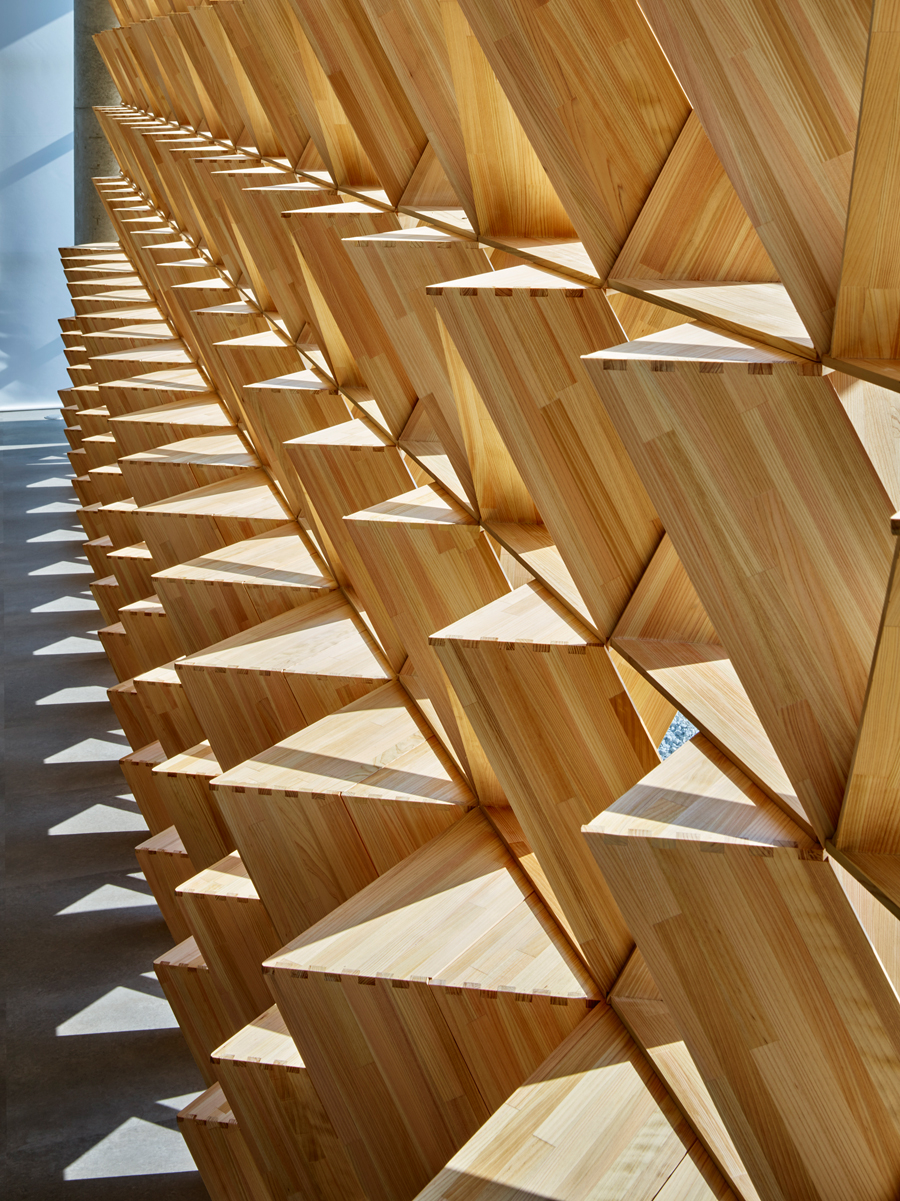
TRUS(S)TOOL WALL
Program_Display Wall | Location_Muroto, Kouchi | Year_2017.3 | Material_Hinoki Cypress Tree | Collaboration_Nada Architecture+Design | Production_Nishizaki Kougei, Shimanto Forestry Cooperative | Structure_Ejiri Structural Engineers | Photo_Takuya Watanabe
高知県の南端、室戸岬の程近くに立つキラメッセ室戸鯨館の改修に伴い、インフォメーションスペースの陳列家具を提案した。ここではトラススツールと名づけたユニットを、海に正対するように角度をふりながら積み上げることで、日射を遮蔽しながらも来館者の視線を海へと誘導することを試みた。
単一では不安定なユニットは集まることで全体が固まり、立体トラスウォールとして構造的強度を獲得した。
素材は油分が多い四万十のヒノキを用いることで、板厚は薄いが粘り強く耐久性の高いものとなった。
また、各ユニットはピンで接合されているため、時間の経過による木の収縮にも追従でき、劣化がひどいものは部分的に交換が可能である。今回は壁として組み上げたが、組み方は使い方に応じて自由であり、必要に応じてベンチ、平台、カウンター等様々に可変させることができる。
太平洋のキラキラとした水面の輝きがヒノキ材の多孔質な壁面にオーバーレイするとき、太陽の光とその影が媒介となり、内部の空間が周辺の環境に溶け出すような現象が生まれた。
Trus(s)tool Wall is a transformable modular furniture set in Muroto Whale Museum at Kochi prefecture.
This display showcase is an assembly of modular units named Truss Stool, and works also as a screen to prevent direct sunlight to the space.
The stool units are made by Hinoki cypress from the region which has the characteristic of high content of oils providing high elasticity in the material. Assembly of the small cells forms a three dimensional truss wall which obtains a strong structural stability. Simple pin connection detail allows units to follow elastic deformations in time, and to transform its composition and shape flexibly by different uses as bench, table, and counter etc. The cellar structure provides spatial diversity with minimum discipline and metabolizes its own body for continuous adaptation to surrounding environments and its uses.
When the surface of Pacific Ocean glistened in the sun, the light and shadow overlays on to the porous cypress wall and creates phenomenal illusion that the space merges into the peripheral environment and scenery.
TRUS(S)TOOL WALL
| Program | Display Wall |
| Location | Muroto, Kouchi |
| Year | 2017.3 |
| Material | Hinoki Cypress Tree |
| Collaboration | Nada Architecture+Design |
| Production | Nishizaki Kougei Shimanto Forestry Cooperative |
| Structure | Ejiri Structural Engineers |
| Photo | Takuya Watanabe |
高知県の南端、室戸岬の程近くに立つキラメッセ室戸鯨館の改修に伴い、インフォメーションスペースの陳列家具を提案した。ここではトラススツールと名づけたユニットを、海に正対するように角度をふりながら積み上げることで、日射を遮蔽しながらも来館者の視線を海へと誘導することを試みた。
単一では不安定なユニットは集まることで全体が固まり、立体トラスウォールとして構造的強度を獲得した。
素材は油分が多い四万十のヒノキを用いることで、板厚は薄いが粘り強く耐久性の高いものとなった。
また、各ユニットはピンで接合されているため、時間の経過による木の収縮にも追従でき、劣化がひどいものは部分的に交換が可能である。今回は壁として組み上げたが、組み方は使い方に応じて自由であり、必要に応じてベンチ、平台、カウンター等様々に可変させることができる。
太平洋のキラキラとした水面の輝きがヒノキ材の多孔質な壁面にオーバーレイするとき、太陽の光とその影が媒介となり、内部の空間が周辺の環境に溶け出すような現象が生まれた。
Trus(s)tool Wall is a transformable modular furniture set in Muroto Whale Museum at Kochi prefecture.
This display showcase is an assembly of modular units named Truss Stool, and works also as a screen to prevent direct sunlight to the space.
The stool units are made by Hinoki cypress from the region which has the characteristic of high content of oils providing high elasticity in the material. Assembly of the small cells forms a three dimensional truss wall which obtains a strong structural stability. Simple pin connection detail allows units to follow elastic deformations in time, and to transform its composition and shape flexibly by different uses as bench, table, and counter etc. The cellar structure provides spatial diversity with minimum discipline and metabolizes its own body for continuous adaptation to surrounding environments and its uses.
When the surface of Pacific Ocean glistened in the sun, the light and shadow overlays on to the porous cypress wall and creates phenomenal illusion that the space merges into the peripheral environment and scenery.









